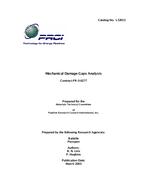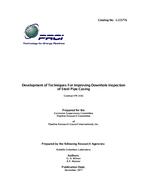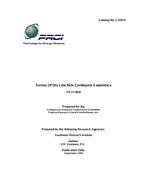Provide PDF Format
PRCI PR-003-0277
- Review & Gap Analysis of Remaining Issues Concerning Mechanical Damage
- Report / Survey by Pipeline Research Council International, 01/01/2002
- Publisher: PRCI
$48.00$95.00
L52013e
Battelle Memorial Institute
Need: Pipelines fail due to various causes. The "outside forces" incident category includes acts of man (such as impact damage by earth moving machinery) but it also embraces acts of nature. Outside forces has been the dominant incident category in most Western World oil and gas transmission pipeline systems. Incidents due to outside forces have been the leading cause of significant failures on transmission pipelines in the USA since formal record keeping and trend analysis of incidents began in the 1970's. This trend remains currently, with these results reflecting incident experience for 2002. While this situation is not expected to change in the near term, the recent data from 2002 indicate corrosion is overtaking outside force as the main failure cause.
Results: The objectives of this report are to evaluate current state of knowledge concerning assessment and management of mechanical damage to pipelines, and identify outstanding issues or gaps to be addressed by the industry. Motivation for such an evaluation and gaps analysis lies in several factors, including much work done has been recently done worldwide. Third-party damage is typically the largest incident category, with the largest consequences, and pending regulatory actions are consequence based, and will require a management strategy to deal with mechanical damage.
Benefit: Recognizing the future importance of a management strategy to deal with the threat of mechanical damage, this report meets the objectives by updating and elaborating work previously addressed in terms of the six worldwide technical objectives in one of four categories more focused on managing the threat posed by mechanical damage. The four categories chosen for this purpose are: prevention/detection; severity assessment and/or prioritization; repair/rehabilitation; and threat management. The majority of the work done pertains to the first two categories, as these are technically complex topics. Much less work unique to mechanical damage is reported for the third category. This is largely because much can be adapted from other repair practices that can be applied to repairing mechanical damage, while rehabilitation practices involving cutouts are generic. Finally, the fourth category relies heavily on the first three, and so is limited in scope. Accordingly, the bulk of this report focuses on prevention/detection, and severity assessment and/or prioritization, with relatively less discussion of repair/rehabilitation and threat management.
Battelle Memorial Institute
Need: Pipelines fail due to various causes. The "outside forces" incident category includes acts of man (such as impact damage by earth moving machinery) but it also embraces acts of nature. Outside forces has been the dominant incident category in most Western World oil and gas transmission pipeline systems. Incidents due to outside forces have been the leading cause of significant failures on transmission pipelines in the USA since formal record keeping and trend analysis of incidents began in the 1970's. This trend remains currently, with these results reflecting incident experience for 2002. While this situation is not expected to change in the near term, the recent data from 2002 indicate corrosion is overtaking outside force as the main failure cause.
Results: The objectives of this report are to evaluate current state of knowledge concerning assessment and management of mechanical damage to pipelines, and identify outstanding issues or gaps to be addressed by the industry. Motivation for such an evaluation and gaps analysis lies in several factors, including much work done has been recently done worldwide. Third-party damage is typically the largest incident category, with the largest consequences, and pending regulatory actions are consequence based, and will require a management strategy to deal with mechanical damage.
Benefit: Recognizing the future importance of a management strategy to deal with the threat of mechanical damage, this report meets the objectives by updating and elaborating work previously addressed in terms of the six worldwide technical objectives in one of four categories more focused on managing the threat posed by mechanical damage. The four categories chosen for this purpose are: prevention/detection; severity assessment and/or prioritization; repair/rehabilitation; and threat management. The majority of the work done pertains to the first two categories, as these are technically complex topics. Much less work unique to mechanical damage is reported for the third category. This is largely because much can be adapted from other repair practices that can be applied to repairing mechanical damage, while rehabilitation practices involving cutouts are generic. Finally, the fourth category relies heavily on the first three, and so is limited in scope. Accordingly, the bulk of this report focuses on prevention/detection, and severity assessment and/or prioritization, with relatively less discussion of repair/rehabilitation and threat management.
Related Products
PRCI PR-3-81
Development of Techniques for Improving Downhole Inspection of Steel Pipe Casing..
$448.00 $895.00





